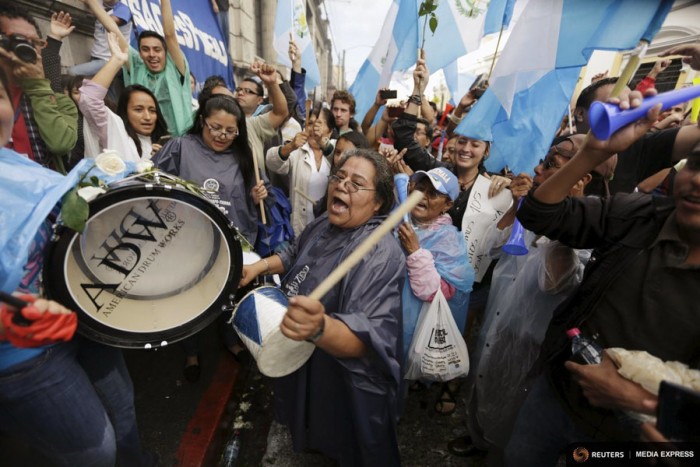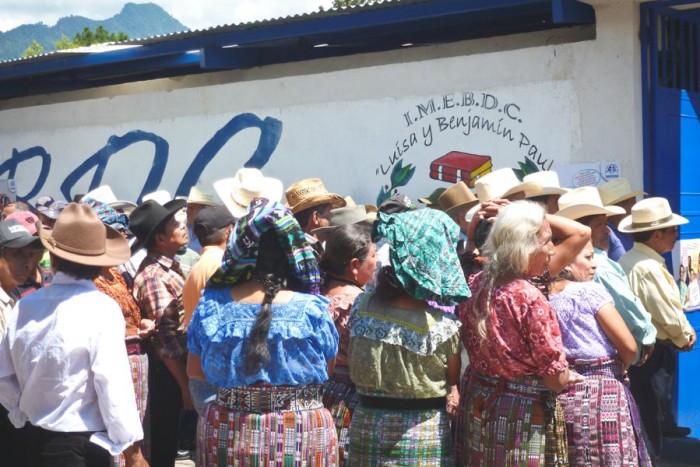
Two years ago, Guatemalan President Otto Perez Molina came to the pueblo where I live, San Pedro La Laguna. The military proceeded him by three days and stayed a week, walking through the streets with shiny guns slung across their chests.
People who normally sit on the street melted into doorways, perhaps remembering the murders here thirty years ago when the military waged a war that took the lives of over 200,000 Guatemalans.
The president arrived in a helicopter with enough time to cut a ribbon for a new road, grandly promising that this torturous and precarious series of jarring potholes used daily by numerous tuk tuks, buses and shuttles, would, through the beneficence of his government, finally be paved.
For the next four months a collection of Maya men with hammers and wheelbarrows made four dollars a day chipping boulders into pebbles to prepare the road for asphalt. There were no steamrollers to move things along and ultimately no asphalt. The workers had diligently forged a hopeless road, a project immediately erased in the rainy season. Everyone cursed the road, but no one was surprised.
Broken promises and corruption are not new in Guatemala. What is new is evidence of official wrongdoing based on wiretaps and emails, instead of on the testimony of witnesses, who are too easily intimidated or killed. International intervention, through the UN Commission Against Impunity in Guatemala (CICIG), brought new forms of gathering evidence along with a mandate to train and support Guatemalan prosecutors in evidence-based prosecutions against entrenched corruption. The work of CICIG had already resulted in high-level money-laundering and fraud indictments.
In April, CICIG released it’s first report on “La Linea,” The Line, a customs scheme in which millions of dollars of bribes were channeled to the highest levels of government in exchange for reduced import duties. The earliest findings implicated Vice President Rosana Baldetti and her personal assistant, though there were hints that President Otto Perez Molina himself was involved.
Read about citizens rising against corruption next door in Honduras.
Following the release of the commission’s report, a group of nine young professionals and students in Guatemala City connected through posts on Facebook. They met and created a hashtag, #RenunciaYa (Resign Already), calling for a non-violent demonstration in May. Among themselves they speculated that perhaps five hundred people, mostly friends, might come.
Instead, thirty thousand people flooded the streets, primarily students from the public universities and young professionals. Many wore masks to hide their faces from the cameras which ring the park in front of the National Palace. Guatemala has a history of killing its activists. During the thirty year genocidal war which ended in 1996, the Guatemalan military exterminated nearly every activist and intellectual in Guatemala along with entire Mayan pueblos. Rural activists and journalists continue to be killed. At the same time, one-half of Guatemala’s population is under the age of 19, born after the civil war, and concerned about their future.

A few days after the may demonstration, the vice president resigned, bowing to public pressure. But protestors didn’t quit there. They continued to demand the resignation of the president. The following weekend’s protest saw students from private university joining those from public schools, a rare union of the middle class with the poor. The masks were abandoned. The protestors stayed through driving rain chanting “RenunciaYa,” banging on pots and singing the national anthem.
Every weekend for nineteen weeks thousands continued to protest, drawing in ever more sectors of Guatemalan society, from indigenous farmers to teachers, health care workers, housewives, religious leaders, impoverished families, gay rights activists and business owners.
CICIG released another report saying it had solid evidence that Perez Molina and Rosana Baldetti were the leaders of La Linea and had pocketed millions of dollars from the scheme. Molina continued to proclaim his innocence. #RenunciaYa called for a Day of Action.
On August 27th, over 100,000 Guatemalans gathered in Guatemala City to demand that President Molina resign and be stripped of legal immunity for crimes committed in office. The crowd carried signs saying, “Yo No Tengo Presidente,” I don’t have a President.
Thousands more joined in the demonstration in Quetzaltenago and rural Guatemala, blocking every major highway. Businesses, including the popular restaurant chain Pollo Campanero, closed in solidarity. As with earlier demonstrations, the protest was non-violent. There were no burning cars or broken windows or thrown rocks. No one was shot or arrested. Rather, a growing sea of Guatemalans understood that their country suffered because of the greed of its leaders.
Over fifty percent of Guatemala’s population lives in poverty or extreme poverty, even though Guatemala has the largest economy in Central America. One in every two children suffers from malnutrition. Health centers and hospitals lack medicine including ibuprofen, insulin and antibiotics. Public schools have no books, desks or electricity. The price of basic food in this agricultural country rises every year. Police lack sufficient gasoline to drive to crime scenes. Meanwhile the president, the vice president and many other officials had pocketed millions of dollars.
On September 2nd, Peréz Molina resigned. The evidence against him was amassed through more than 90,000 wiretapped phone calls, 6000 emails and 175,000 documents.
But it was the protests which propelled evidence into action, demanding resignations and successfully pressuring Congress to take action. Even the conservative interim president, who will serve until the end of January, invited protestors to work with him in forming a transitional administration. The people had won.
I asked my friend Juan, who is a teacher, if he was surprised that the police did not “remove” the protesters .
“We have freedom of expression in our Constitution. People can legally demonstrate,” Juan said emphatically.
“But when the protests started, did you think Molina would actually resign and end up in jail?” I asked.
“Of course I knew we would win,” he told me, “there are more of us than there are them.”
But it took the magnitude of the protests to show just how widespread dissatisfaction was.

Guatemalans voted in the scheduled general election on September 6th, despite calls that the elections be postponed until the laws were reformed to eliminate influence peddling through campaign money from drug trafficking and the weathy elite (an amount CICIG estimated as accounting at fifty percent of campaign spending).
Still, the influence of the protests on the election was striking. Wealthy right-wing businessman Manuel Baldizon, the front-runner before the protests, came in third, his party tainted by corruption charges.
Twenty-four percent of the vote went to Jimmy Morales, a television comedian whose outstanding qualification was a lack of experience in government and his assurance that he was not a thief. Few Guatemalans know much about him though he has disturbing ties to the right-wing military elite. He will face Sandra Torres in a run-off election October 25. Torres is the ex-wife of a former president, whose family is also tainted by corruption charges, but who promises to increase benefits to the poor.
“There is no one I want to vote for,” Juan said. “But I am happy that the protests will give the new government a reason not to commit the same errors.”
Update 10/26/15: Outsider candidate and TV comedian Jimmy Morales won a landslide victory in the a runoff election against former first lady Sandra Torres. Morales is set to take office in January 2016.


Thanks for the great article! I hope there will be more to keep us connected to Guatemaya!!